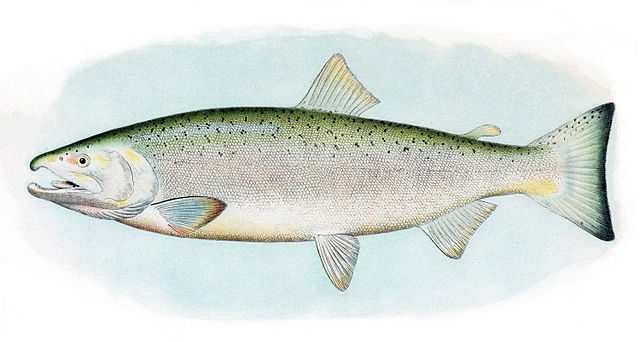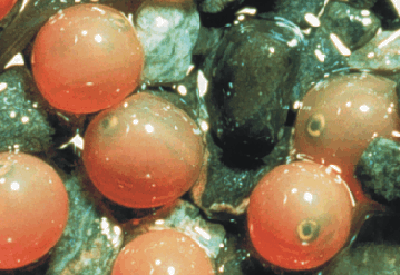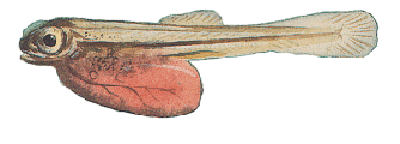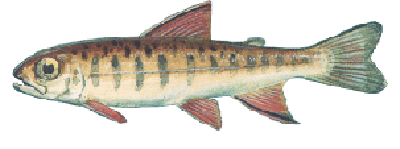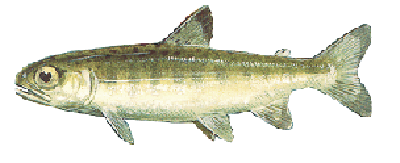Common Names:
Silver salmon, hook nose salmon, blueback salmon, jack salmon, salmon trout, silverside salmon and white salmon.
Description:
The coho salmon is bluish-black with silver sides in saltwater; black spots on the back and upper part of the caudal fin. Smaller and slimmer than the chinook salmon; the inside of the mouth is gray or black with white gums. Coho salmon reach up to 38.5-inches in length and can weigh as much as 36-pounds. However, they usually weigh between 6- to 12-pounds. IGFA World Record, All Tackle, is 33-pounds, 4-ounces (Salmon River, Pulaski, New York). The tippet class IGFA World Record is 21-pounds, 8-ounces on 16-pound test (Kenai River, Cordova, Alaska).
Life Cycle:
Spawning occurs from October to January, with the eggs hatching the following spring. Coho fry remain in streams for over a year. Moving seaward the following spring, most cohos return to spawn when they are three years old. The mature male fish which return after two years are known as “jacks” and in Oregon and Washington, the abundance of “jacks” are used to predict the next year’s three year old return. In the Great Lakes, coho spawning mirrors that of its Pacific grandparents. The swing in time frames is all about water levels and weather.
Habitat and Ecology:
Coho salmon utilize freshwater, nearshore and offshore environments during its life cycles. Coho salmon spawn in the same environment as chinook salmon; however, coho prefer lower stream velocity, shallower water and smaller gravel. Most coho fry stay in the stream for over a year feeding on aquatic insects, zooplankton and small fish. Adequate stream cover is important to fry survival, as is high dissolved oxygen levels.Mortality is especially high during freshwater life stages, often a result of poor forest and agricultural management practices that lead to siltation, which may ruin spawning beds or smother the eggs. Migrating coho salmon also face physical obstacles and high water temperatures resulting from dams, inadequate water flows due to diversions for irrigation and impoundment of water for power generation. Once reaching the estuaries, coho salmon fall prey to a number of other species and may be impacted by human changes, such as shoreline development, residential drainage and the filling of marine wetlands. The time spent in this habitat is critical to the development of the species and their ability to survive in the offshore environment.
Range:
Coho salmon spawn in coastal streams from Northern Japan to the Anadyr River in Siberia and from Monterey Bay in California and Point Hope in Alaska. This species can also be found in the ocean from Baja, California, to the Bering Sea in Alaska. Major U.S. spawning grounds are in Alaska, Washington and Oregon. After being introduced the Great Lakes from their Pacific waters, they have become abundant. The fourth most abundant salmon species, coho salmon is a culturally and economically important resource, and an important subsistence fish. Coho salmon is commercially fished from Northern California north to Norton Sound in Alaska; 75% of the total U.S. catch comes from Alaska.
Description:
During their ocean phase, Coho have silver sides and dark blue backs. During their spawning phase, the jaws and teeth of the coho become hooked, and they develop bright red sides, bluish green heads and backs, dark bellies with dark spots on their back. Sexually maturing coho develop a light pink or rose shading along the belly and the males may show a slight arching of the back. Mature coho salmon have a pronounced red skin color with darker backs. Mature females may be darker than males, with both showing a pronounced hook on the nose.
HABITAT
Pacific:
Coho salmon utilize freshwater, nearshore and offshore environments during its life cycles. Coho salmon spawn in the same environment as chinook salmon; however, coho prefer lower stream velocity, shallower water and smaller gravel. Most coho fry stay in the stream for over a year feeding on aquatic insects, zooplankton and small fish. Adequate stream cover is important to fry survival, as is high dissolved oxygen levels. Mortality is especially high during freshwater lifestages, often a result of poor forest and agricultural management practices that lead to siltation, which may ruin spawning beds or smother the eggs. Migrating coho salmon also face physical obstacles and high water temperatures resulting from dams, inadequate water flows due to diversions for irrigation and impoundment of water for power generation. Once reaching the estuaries, coho salmon fall prey to a number of other species and may be impacted by human changes, such as shoreline development, residential drainage and the filling of marine wetlands. The time spent in this habitat is critical to the development of the species and their ability to survive in the offshore environment. Coho spend approximately the first half of their life cycle rearing and feeding in streams and small freshwater tributaries. Spawning habitat is small streams with stable gravel substrates. The remainder of the life cycle is spent foraging in estuarine and marine waters of the Pacific Ocean.
Great Lakes:
They were introduced into the Great Lakes in 1873 but the first successful plantings weren’t until 1966. There was much excitement among anglers and fish managers when coho made their first spawning run in the fall of 1967. People now come from all over the world to fish Michigan’s great coho fishery. Although coho do spawn in Great Lakes tributaries, present fish stocks are maintained mainly by fish culture and stocking. Spawning runs up tributary rivers occur from early September to early October. Females excavate a nest in a tributary stream’s gravel bed (Redd). Both adult die soon after spawning. The next spring the eggs hatch and the young remain in the gravel for 2-3 weeks. When they emerge (March to July), some migrate downriver almost immediately. Most, however, wait a year or longer before descending to the lakes. Once in the lake, they stay near shore for a few months, then seek deeper waters. Young coho eat greedily and grow rapidly. Most coho spend about 18 months in the lake, then return to their parent streams to spawn (at age three or four). As soon as they are large enough, young coho begin to eat smaller fish, mostly of other fish species. In the Great Lakes, larger coho feed on smelt and alewives. They compete primarily with steelhead for food. Coho are preyed upon by predatory fish and birds while they are small, and residual numbers of sea lampreys also take their toll of coho populations.
Diet:
In their freshwater stages, coho feed on plankton and insects, and switch to a diet of small fishes as adults in the ocean. Spawning habitat is small streams with stable gravel substrates.
Alaska Fishery:
Coho salmon are the backbone of the Alaska troll fishery, however, the majority are caught by the net fishery (Gillnet and Seine). Coho salmon average 3.5% by fish of the annual Alaska salmon harvest; 5.9% by weight of the annual Alaska salmon harvest. (Alaska Seafood Marketing Institute, 2003, p.2) This species is a game fish and provides fine sport in fresh and salt water from July to December, especially with light fishing tackle. It is one of the most popular sport fish in the Pacific Northwest of the United States. Its popularity is due in part to the reckless abandon which it frequently displays chasing bait and lure while in salt water, and the large number of coastal streams it ascends during its spawning runs. Its habit of schooling in relatively shallow water, and often near beaches, makes it accessible to anglers on the banks as well as in boats. Ocean caught coho is regarded as excellent table fare. It has a moderate to high amount of fat, which is considered essential when judging taste. Only Spring Chinook and Sockeye salmon have higher levels of fats in their meat. Historically, the coho, along with other species, has been a staple in the diet of several Indigenous Peoples, who would also use it to trade with other tribes farther inland. The coho salmon is also a symbol of several tribes, representing life and sustenance.
Sources:
NOAA Office of Protected Resources I Michigan Department of Natural Resources I U. S. Fish & Wildlide Service
FLY FISHING FOR COHO SALMON
Coho salmon are the last of the Pacific salmons to make a showing. All the fishing activity is around the spawn cycle, which is typically at its best in September and October, but we’ve caught coho in July and August. In the Great Lakes the spawn can go on through January.
All of the spawn activity for coho, like all salmons, depends on the time of year, weather, water temperatures and most of all – water levels. Coho need shallower streams than chinook and smaller gravels sizes to commit to their Redds. Although all females die post spawn, they will dig two or three Redds to lay eggs in.
Some males will survive the spawn and come back.
Rods:
While the standard for fly fishing for coho in Alaska has been, until a few years ago, the standard 9-foot long, 4-piece, 7- to 9-weight with your favorite action, but today the switch rod and even spey rods are in vogue, and for good reason:
- You can cover more “ground.”
- Cast “much” further with much less effort using a switch, which we opine as the best of all worlds. You can overhand if the situation merits that kind of assault, or simple employ any number of “spey-like” offensives and, of course, roll cast.
- Brush, trees and steep banks that were restrictive impediments behind you are no longer in-play.
- The only negative that if you’re switch-less – it’s another expense, but well worth it.
Reels:
Always get the best you can afford, but with this fresh water species all you need is about 150-yards of 20-pound backing. However, the drag system remains a very important consideration. Good reels last and last and keep on lasting. A cheapo reel will always let you down at the wrong time.
Fly lines:
For conventional fly rods use a floating line and have available a sink tip. A RIO Mow 10-footer of your choice will do the trick.
The best fly line for a switch rod is RIO’s Switch Chucker. And keep a RIO Mow 10 footer at the ready when you come to a deep holding pool. You’ll out-fish everyone.
Leaders:
You can get away with 10-pound, but let’s help the fishery out and go a little heavier – say 16-pound. Monofiliment preferred and non-slip as terminal knot. A 9-foot or a little longer leader works fine. yes, longer if you need it.
Flies:
A Wooly Bugger, Muddler Minnow, flash flies and egg-sucking leaches in an assortment of sizes and myriad of colors – from hot pink to black. You can get action from a popper when they’re hot-to-trot.
When to Fish:
Unequivocally, low light – early or late. Will you catch them at noon? Yes, but a foggy start or late go is best.
Illustrations provided by USFWS – drawn by Harry Heine


